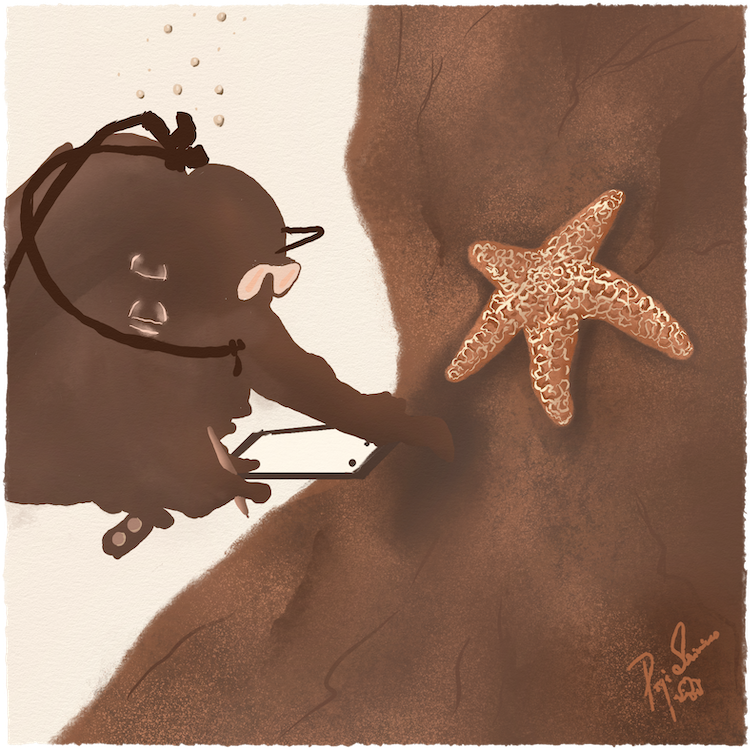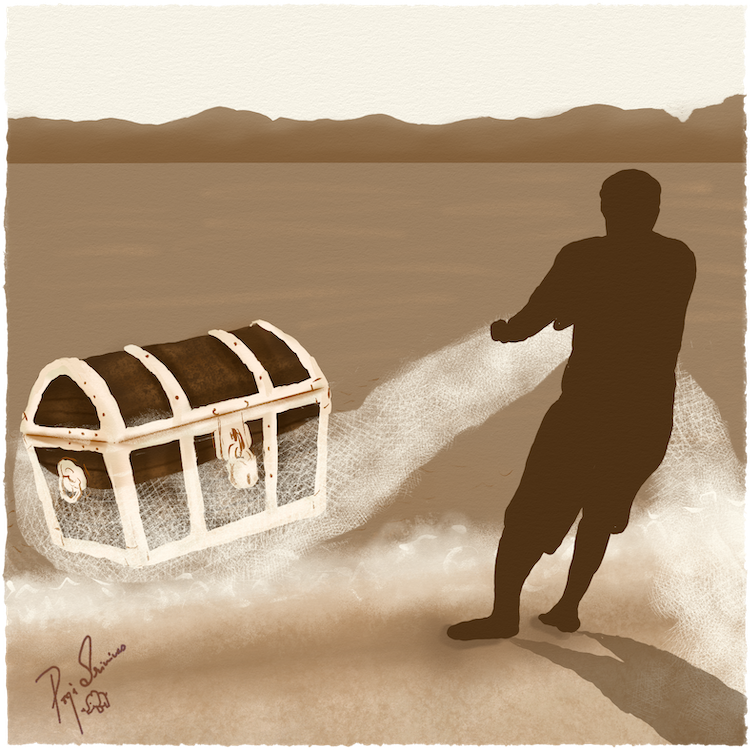Inktober 2025 Week 2
This Inktober, every prompt is a clue. I'm embarking on an Inktober journey through the lens of a detective, exploring each day's challenge with intellectual curiosity. To capture a timeless sense of elegance and intrigue, the series will be crafted with sepia-toned (digital) colored pencils against the rich texture of hand-made ivory deckled paper.


Day 6: Pierce
"When you pierce through the lies, you find the echo of truth their fear can't silence.”
The Reid Technique is a controversial, nine-step interrogation process designed to psychologically overwhelm a suspect. By using intense pressure, the technique forces a suspect past their initial denials. Interrogators escalate fear of severe punishment while offering a rationalized "theme" to make a confession seem like the only way out. This method was effective in securing admissions from killers like the "Night Stalker," Richard Ramirez, but its aggressive nature is highly debated. Critics point to the controversial interrogation of Brendan Dassey as proof of the high risk for false confessions.
Where should law enforcement draw the line between solving a crime and coercive tactics?


Day 7: Starfish
"Just like the starfish, we the power to heal and renew ourselves."
Starfish are famous for their ability to regenerate lost arms and, in some cases, grow a new, complete body from a detached limb. However, an unprecedented decade-long epidemic known as Sea Star Wasting Disease (SSWD) nearly extinguished that power for these resilient creatures. Starting in 2013, billions of sea stars across the Pacific coast succumbed to a gruesome illness where their tissues would "melt," arms would twist, and the animals would rapidly disintegrate. This mass die-off, the largest known marine wildlife epidemic affected over 20 species of starfish. The loss of these keystone predators allowed their primary prey, sea urchins, to dramatically increase in number. The resulting urchin explosion has led to the widespread destruction of vital kelp forests along the coast.
For years, the cause remained an elusive mystery, baffling scientists who pursued numerous false leads. Through extensive and meticulous investigation, scientists finally identified the definitive killer as a bacterium known as Vibrio pectenicida. This breakthrough, achieved through dedicated research, was critical for understanding the devastating ecological ripple effect. Researchers are now actively pursuing solutions like captive breeding and immunity studies to aid in the recovery of this essential marine species.
What role can we play in protecting and restoring these delicate ocean ecosystems?


Day 8: Reckless


"His power came from meticulous control, yet it was shattered by his own reckless impulse for fame."
For three decades, the BTK Killer was Wichita's most terrifying phantom. Operating with chilling precision, he claimed ten victims between 1974 and 1991 and then vanished, leaving the investigation completely cold. The killer hid in plain sight as Dennis Rader, a family man and church president, the ultimate exercise in meticulous control over his secret life. The mystery of his identity became one of America's most infamous cold cases.
The case remained frozen until 2004 when, unable to stand the silence, Rader’s ego reignited the investigation. He began a brazen campaign of taunts, sending letters and packages to the media, craving credit for his forgotten crimes. This cat-and-mouse game was his undoing. After asking police in a coded message if a floppy disk could be traced (they publicly replied it was safe), he sent one to a TV station.
Investigators recovered metadata from a deleted document on the disk that pointed directly to "Christ Lutheran Church" and a user named "Dennis." The trail led straight to Rader. A final DNA test confirmed the phantom had a face, ending a 30-year reign of terror.
Do you think his taunts were a calculated risk that failed, or an unconscious desire to finally be stopped?
Day 9: Heavy


"A heavy chest holds the heaviest of secrets."
From the collection of One Thousand and One Nights comes one of the world's earliest detective stories. The tale begins when a fisherman, struggling to make a living, pulls a heavy, locked chest from the depths of the Tigris River. He brings the mysterious find before the Caliph, Harun al-Rashid. When the chest is forced open at the Caliph's command, it reveals a horrific secret: the dismembered body of a young woman.
This gruesome discovery sets in motion a desperate quest for justice. The enraged Caliph orders his vizier, Ja'far, to find the murderer within three days or face execution himself. The command launches a frantic investigation into the woman's identity and the events that led to her tragic end being sealed within the chest. The story masterfully builds suspense as Ja'far follows a trail of clues, navigating a city of secrets to unmask a killer and save his own life.
Without modern forensics, how would you begin to solve such a chilling and mysterious crime?
Day 10: Sweep
"The most dangerous secrets are the ones we try to sweep under the rug."
In the movie Swept Under, Morgan, a highly meticulous professional crime-scene cleaner, specializes in making horrifying murder scenes spotless. For Morgan, sweeping is a methodical process where she often uncovers clues the police miss. While working on a gruesome case, she finds a small but crucial piece of evidence: the broken tip of a distinctive walking cane. This discovery forces her to cross the professional line and launch her own investigation. The tools of her trade, her brushes and brooms, become visual motifs for the theme of erasure and revelation.
The clues she's swept up connect to a series of unsolved murders. Morgan's ability to mentally reconstruct the crime while physically cleaning the aftermath makes her the key to the mystery, and the next target of the meticulous killer. The thriller escalates into a desperate struggle for survival, where the one person hired to erase the scene is the only one who can expose the truth. The final revelation confirms the chilling idea that the killer was someone close to the investigation all along, underscoring the chilling reality that the ultimate cover-up was executed right in front of the authorities.
When a crime-scene cleaner has unsupervised access to every detail, who is truly in control of the evidence?


Day 11: Sting
"The sting of betrayal outlasts the sweetness of deceit, leaving only the bitter aftertaste of regret."
- Andrew Pacholyk
In Agatha Christie's Murder in the Clouds, on a Paris-to-London flight, notorious moneylender Madame Giselle is found dead. A buzzing wasp suggests a fatal allergic reaction, but the astute Hercule Poirot suspects foul play. He discovers the real weapon: a tiny, poison-tipped dart.
This turns the cramped airplane cabin into a classic locked-room mystery with eleven suspects, including a charming dentist, a young hairdresser, and a debt-ridden aristocrat. The case takes a twist when the murder weapon, a South American blowpipe, is found tucked beside Poirot's own seat.
As Poirot delves into the victim's life of loan sharking and blackmail, he realizes the wasp was a brilliant misdirection. The killer had the audacity to strike in the enclosed space, seemingly an impossible feat.
How did the killer manage to conceal their poisonous act within a cabin full of witnesses?


Day 12: Shredded
"Trust, once shredded, reveals the fragility of digital fame."
Robert Brown amassed a huge online following by showcasing what looked like impossible guitar skills, becoming a star in the metal community. He was celebrated until prominent YouTube musicians like Jared Dines exposed his fake shredding in 2018. They proved he was merely miming to sped-up, pre-recorded audio tracks, creating a convincing but fraudulent spectacle.
The scandal spiraled beyond fake musicianship as numerous fans and collectors came forward with serious allegations of fraud. They accused Brown of stealing high-end guitars, taking payments for instruments he never delivered, and scamming community members out of thousands of dollars.
The case became a cautionary tale about the power of digital deception and the betrayal of trust within a passionate fan community. The investigation revealed a pattern of behavior that went far beyond simply faking musical talent, transforming a tale of musical deceit into a chronicle of real-world crime.
In an age of digital manipulation, how can we separate genuine talent from sophisticated fraud?




